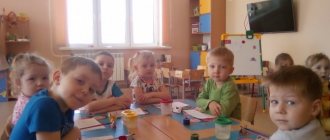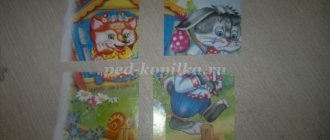Exciting activities for children aged 3 to 4 years in drawing with colored pencils, gouache and watercolors in traditional and non-traditional ways develop aesthetic perception. Kindergarten is the best place for developing emotional responsiveness, cultivating a sense of beauty, developing imagination, independence, perseverance, accuracy, hard work, and developing visual skills.
Fine arts lesson on the topic “Planes are flying” in junior kindergarten groups
Before preparing a lesson for children in the younger groups of kindergarten, you need to choose an interesting topic. In the process of visual activity, children must reflect life impressions. Drawing in the second junior group “Planes are flying” teaches you to depict objects and phenomena that form clear ideas about the environment.
Fine art lesson on the topic “Planes are flying” for younger groups
Example of drawing lesson notes
The program content should contain children's material, which must be conveyed in a drawing, reflecting the phenomena of modern life. Kids can draw airplanes flying in the sky. In addition, children should learn to draw straight lines in different directions when drawing objects related to flight. This technique contributes to the development of aesthetic perception.
Summary of a drawing lesson in the second junior group “Road for cars”
Elena Zalogina
Summary of a drawing lesson in the second junior group “Road for cars”
Summary of a drawing lesson in the 2nd junior group “ Road for cars ”
Goal: We consolidate the concept of a passenger car; We fix how to hold brushes correctly, learn to draw two straight parallel lines and paint them inside; We develop patience and accuracy; Fostering an interest in creativity
Materials: brushes, jars of paint, jars of water, napkins for each child; three toy cars , a finished sample drawn ; pattern with one stripe, pattern with two stripes.
cars came to visit us today , they are magical and came to us from the magical country of Machineland . (shows three small cars )
.
-What kind of cars ? (There are trucks , but what about these? ... (passenger cars)
-What color are they?
— What does the car ? (wheels, body, headlights, doors, windows, steering wheel, windshield, mirrors)
— What are the mirrors in the car ? (to see cars that are driving behind)
Let's show our cars how we can do it (physical education minute)
:
We're going, we're driving a car , (turn the steering wheel)
We press the pedal. (raise, lower the toe of the right foot)
Turn the gas on and off (with your right hand back and forth)
We look intently into the distance. (raise palm to forehead)
The wipers clean the glass. (arms are bent at the elbows, we tilt our palms in
To the right, to the left, cleanliness. one way, then the other way)
The wind ruffles my hair. (ruffled hair)
We are drivers, no matter where we go! (turn the steering wheel)
Educator: guys, do you know that our cars are very sad and upset! Do you know why? Yes, because they were driving towards us along a bad road . The road was full of holes , ditches and mounds! They almost broke down, and they still had to return home, so they were sad. Let us draw the cars a new smooth , smooth and colorful road . (Yeees)
Educator: Then, we sit down at our tables, but no one takes anything, you need to listen carefully to how we are going to draw so that it turns out correctly and only after I say loudly: DRAW, you will start drawing . Agreed?
— You have brushes, paints, jars of water and napkins on your tables. Now each of you will draw a part of the road , evenly and neatly, then we will let the drawing dry and collect our drawings into one long and beautiful road and show it to the cars , imagine how happy they will be. Look how I drew my path . To draw yours, you need to draw one line from top to bottom, then a second and paint in the middle (pre- drawn step-by-step drawings and on them I seem to draw repeat with me in the air ).
- Now let’s pick up the brushes correctly (the teacher shows how to do it and looks at how the children are holding it, if it’s wrong, corrects it) and-and-and, DRAW (speaks loudly)
The children begin to draw , and the teacher draws with them again from the very beginning and pronounces: first one line from top to bottom (looks at how the children do it, then not far away the second line (looks at the children)
and paint over (the teacher went down the rows to control the children’s process, directing or correcting, or praising the children who got it right).
As the drawings are completed, the teacher takes the children's work to dry, praises each child and thanks them for their help on behalf of the machines .
- Well done guys, you tried very hard, the cars are happy and happy . After our walk, the drawings will dry and we will assemble a wonderful, smooth road for our guests .
Lesson Objectives
The main task is to form a self-sufficient, multifaceted, creative personality. Drawing for the 2nd junior group “Planes are flying” promotes the development of creative and cognitive activity and the enrichment of new knowledge. The child begins to get acquainted with the world around him.
Important! If you use non-standard materials and techniques, then you can easily interest children in visual arts. This method turns the process into an interesting hobby.
Airplane drawing problems
Educational tasks:
- develop the ability to listen carefully to the teacher’s explanation;
- cultivate positive emotions from classes and free motor activity;
- develop the ability to interact and establish contacts with adults and each other through speech;
- cultivate interest in drawing and evoke an emotional response.
Developmental tasks:
- develop the ability to independently and at the request of an adult take part in conversations;
- increase curiosity and cognitive interest in transport objects;
- develop fine motor skills, auditory perception, clarify and consolidate the articulation of the sound “u”;
- promote the development of skills in expressive and emotional transmission of game images.
Abstract of OOD on drawing for the junior group “Road for a car”
Agafonova Anna
Abstract of OOD on drawing for the junior group “Road for a car”
On the topic: “ Road for a car ”
Goal: to develop the ability to hold a brush correctly, remove excess paint, and draw a straight line from left to right.
1. Teach children to draw wide and narrow horizontal lines;
2. Develop in children a plot-game concept based on impressions of the environment;
3. Develop fine motor skills of the hands.
Integration of educational areas:
Social communicative development, cognitive development, speech development, artistic and aesthetic development.
Materials and equipment: toy truck, paints, sippy cup, album, brushes.
Preliminary work: observing passing cars and wheel tracks on the roads . Games with cars, riding dolls.
Materials and equipment needed for the lesson
Materials and equipment to perform the work
For the lesson to go perfectly, you need to select a sheet of light blue paper, light gray gouache paints, brushes, jars of water, paper and cloth napkins, an easel, a toy aircraft, pictures of an airliner, a poster with flying planes.
Two toy airplanes are suitable as demonstration material.
For your information! From the handouts, it is recommended to prepare a large sheet of paper on which the flight of an airliner is depicted.
Progress of the lesson:
So that I can take you
I don't need oats.
Feed me gasoline
Give me rubber for my hooves,
And then, raising dust,
He will run. ( Automobile )
.
- That's right, this is a car . Have you seen how many cars are on the streets of our city? And they are all different. What cars did you see on the way to kindergarten? (Children's answers)
.
-What color are they?
There are different cars -
Blue and red
The tires rustle loudly,
They are in a hurry to go to kindergarten.
— One of the cars came to us for a lesson (showing a toy)
. Let's look at it. What colour is he? What parts does it consist of?
- Let's try to draw a car . But every driver wants his car to be special. He chooses a car of the color he likes. (Ask the children what color they want to paint their car ).
a drawing of a car on your tables . You will carefully paint them with your favorite color and draw wheels. And then our car will be able to drive along the city street.
— See how to carefully paint a car . Mine will be red. I take the brush by the iron skirt, wet it in water, then pick up paint, and remove excess paint on the edge of the can. I move the brush along the drawn line without lifting it from the sheet. I carefully paint the car . I rinse the brush in the jar and dry it on a napkin. I take black paint on a brush, trace the outline of the wheels and paint over them.
- Let's take brushes and try to trace the contour of the car .
- Now choose the paint that you need for your car .
Independent work of children (the teacher provides individual assistance.)
At the end of the lesson, the children's drawings are placed on a pre-prepared image of a city street . Together with the children, the teacher examines the drawings and notes their careful execution.
Preliminary work with children, discussion of the topic
At the first stage, the image of the aircraft is examined, the idea of the features of the appearance of the airliner (flying in the sky, through the air) is clarified. In addition, it is possible to sculpt an airplane and read a fairy tale.
Demonstration of materials
Which image to choose for printing on paper
Before choosing a sample to put on paper, the teacher introduces the children to the world of art. This method serves to develop a basic understanding of works of decorative and applied art and architecture. The teacher invites the kids to look at the template - an airplane.
Formation of CGN and self-care skills in young children
On the topic: methodological developments, presentations and notes
Topic: “Spring days” Goal: To promote the development of children’s cognitive activity, to enrich their ideas about spring natural phenomena.
Notes on walks with children of the first junior group.
Goal: To consolidate and expand children’s initial knowledge about domestic animals and birds. Objectives.
Goal: To consolidate and expand children’s initial knowledge about domestic animals and birds. Objectives.
Goal: To consolidate and expand children’s initial knowledge about domestic animals and birds. Objectives.
Summary of the final lesson in the first junior group Final lesson in the first junior group “Train travel”.
Goal: Formation of parents’ ideas about the development of cognitive processes in children 2-3 years old. Objectives: 1. Expanding parents' knowledge about the characteristics of forms.
Source
Questions for children based on their drawings
At the end of the lesson, the teacher can ask the children questions to reinforce the material:
- Children, what did you draw?
- How did you draw airplanes?
- Did you like drawing the plane?
The teacher asks questions to the children based on their drawings
When creating a drawing, kids should imagine the surrounding objective world. And thematic lessons play an important role in this. Drawing on the theme “Planes are flying” is an excellent choice for developing imagination and increasing children’s interest. The main thing is to praise the young artists at the end of the lesson, even if they didn’t do everything right.


